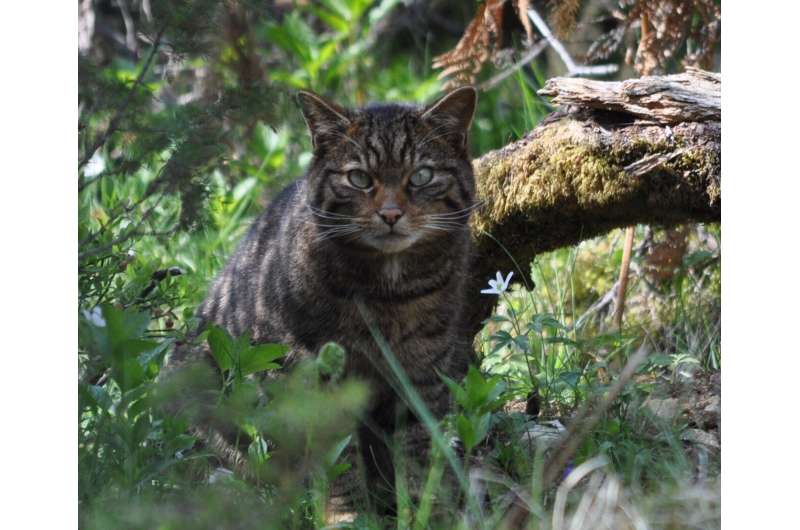This article has been reviewed according to Science X's editorial process and policies. Editors have highlighted the following attributes while ensuring the content's credibility:
fact-checked
peer-reviewed publication
trusted source
proofread
Genetic analysis shows European wildcats avoided introduced domestic cats for 2,000 years

Domestic cats introduced from the Near East and wildcats native to Europe did not mix until the 1960s, despite being exposed to each other for 2,000 years, according to two research papers published in Current Biology.
An international team has found new archaeological and genetic evidence which transforms our understanding of the history of cats in Europe. The team sequenced and analyzed both wild and domestic cats, including 48 modern individuals and 258 ancient samples excavated from 85 archaeological sites over the last 8,500 years. They then assessed the patterns of hybridization after domestic cats were introduced to Europe over 2,000 years ago and came into contact with native European wildcats.
The results of the studies demonstrate that, since their introduction, domestic cats and European wildcats generally avoided mating. About 50 years ago in Scotland, however, that all changed. Perhaps as a result of dwindling wildcat populations and a lack of opportunity to mate with other wildcats, rates of interbreeding between wild and domestic cats rose rapidly.
Jo Howard-McCombe from the University of Bristol and the Royal Zoological Society of Scotland explains, "Wildcats and domestic cats have only hybridized very recently. It is clear that hybridization is a result of modern threats common to many of our native species. Habitat loss and persecution have pushed wildcats to the brink of extinction in Britain. It is fascinating that we can use genetic data to look back at their population history, and use what we have learnt to protect Scottish Wildcats."
Professor Greger Larson, from the University of Oxford, says, "We tend to think of cats and dogs as very different. Our data suggests that, at least with respect to avoiding interbreeding with their wild counterparts, dogs and cats are much more similar to each other than they are to all other domestic animals. Understanding why this is true will be fun to explore."
Professor Mark Beaumont, from the University of Bristol, adds, "The nature of the Scottish wildcat and its relation to feral domestic cats has long been a mystery. Modern molecular methods and mathematical modeling have helped to provide an understanding of what the Scottish wildcat truly is, and the threats that have led to its decline."
Domestic animals including cattle, sheep, goats, dogs, and pigs have been closely associated with people since the emergence of farming communities more than 10,000 years ago. These tight relationships led to the human-mediated dispersal of plants and animals well beyond their native ranges.
Over the last decade, genomic sequences of modern and ancient individuals have revealed that, as domestic animals moved into new regions, they interbred with closely related wild species, which has dramatically altered their genomes. This pattern has been seen in every domestic animal, except dogs. It would be fascinating to know whether domestic cats interbred with European wildcats, but the decline of native wildcat populations across Europe, and the lack of ancient cat genomes has made it difficult to do so.
The two studies, were carried out at universities in Munich, Bristol, Oxford and the Royal Zoological Society of Scotland.
More information: Limited historical admixture between European wildcats and domestic cats, Current Biology (2023). DOI: 10.1016/j.cub.2023.08.031. www.cell.com/current-biology/f … 0960-9822(23)01073-4
Genetic swamping of the critically endangered Scottish wildcat was recent and accelerated by disease, Current Biology (2023). DOI: 10.1016/j.cub.2023.10.026. www.cell.com/current-biology/f … 0960-9822(23)01424-0
Journal information: Current Biology
Provided by University of Oxford

















